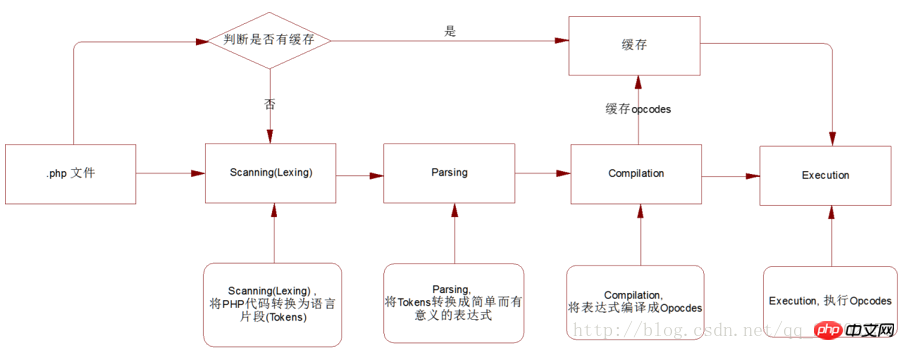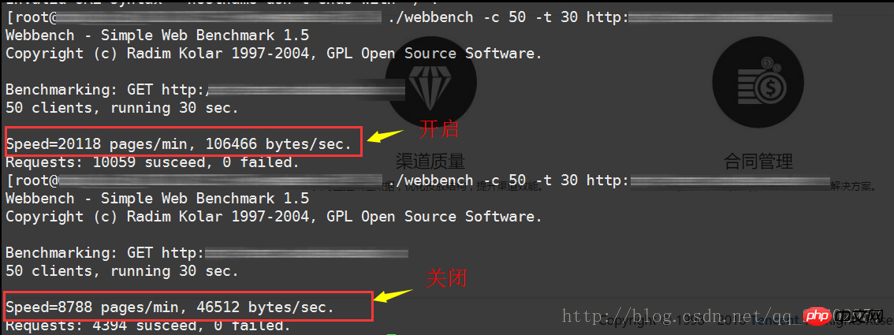Opcode caching makes PHP even more powerful
As we all know, php is an interpreted language, and its execution can be divided into the following processes:
Scanning (Lexing), Convert PHP code into language fragments (Tokens)
Parsing, convert Tokens into simple and meaningful expressions
Compilation, compiles expressions into Opocdes
Execution, executes Opcodes sequentially, one at a time, thereby realizing the functions of PHP scripts.
In this case, repeated requests for the same file will require continuous parsing, compilation and execution of PHP scripts, consuming too many resources.
php traditional operating mode:

In order to solve this problem, opcodecaching technology came into being.
So what is opcode cache?
After the interpreter completes the analysis of the script code, it generates intermediate codes that can be run directly, also called operation codes (Operate Code, opcode). Opcode caching is to cache the compiled Opcode code in the memory. The next time you execute this script, you will directly find the opcode code in the cache and directly execute the last step without the need for intermediate steps. Its purpose is to avoid Repeat compilation to reduce CPU and memory overhead.
After the interpreter completes the analysis of the script code, it generates intermediate codes that can be run directly, also called operation codes (Operate Code, opcode). Opcode caching is to cache the compiled Opcode code in the memory. The next time you execute this script, you will directly find the opcode code in the cache and directly execute the last step without the need for intermediate steps. Its purpose is to avoid Repeat compilation to reduce CPU and memory overhead.
Cache operation mode:

opcache is an opcode cache tool.
The biggest difference between Opcache and other caching tools, which can also be said to be its advantage, is that it has entered the php source code tree and become an official product. It will always be updated with php, while the others have been around for a long time. It is no longer updated. Currently, it does not support the new version of PHP or has poor compatibility. Secondly, after testing, opcache is also more efficient than other tools.
So how to enable the use of opcache?
Now that opcahce has entered the PHP source tree, as a built-in tool, the opening method must be very simple. The following is the recommended configuration:
zend_extension=.././...php_opcache.dll(路径) opcache.memory_consumption=128 #共享内存opcache.interned_strings_buffer=8 #存储临时字符串opcache.max_accelerated_files=4000 #缓存文件数opcache.revalidate_freq=60 #缓存时间opcache.fast_shutdown=1opcache.enable_cli=1 opcache.enable=1 #是否开启opcode缓存
You only need to remove the previous; .
Of course opcache has many configurations, so I won’t list them all here. The above ones are standard configurations and can meet general needs.
Theoretically, the larger the PHP file and the more complex the logic, the more obvious the effect of opcache will be, and it will play a great role in speed and anti-concurrency.
The test results in the local environment are as follows (computer performance is limited):

Service Server test:


There is a significant improvement in efficiency.
It should be noted that since opcache will cache the opcode executed for the first time in the file, it should not be opened in the test environment. The reason is that you know that the code is changed during development, but the result is different. Unchanged…………..
To manually clear the opcache cache, you need to run opcache_reset() to clear it, so if opcache is configured online, it needs to be cleared You can use this function.
The above is the detailed content of Opcode caching makes PHP even more powerful. For more information, please follow other related articles on the PHP Chinese website!

Hot AI Tools

Undresser.AI Undress
AI-powered app for creating realistic nude photos

AI Clothes Remover
Online AI tool for removing clothes from photos.

Undress AI Tool
Undress images for free

Clothoff.io
AI clothes remover

Video Face Swap
Swap faces in any video effortlessly with our completely free AI face swap tool!

Hot Article

Hot Tools

Notepad++7.3.1
Easy-to-use and free code editor

SublimeText3 Chinese version
Chinese version, very easy to use

Zend Studio 13.0.1
Powerful PHP integrated development environment

Dreamweaver CS6
Visual web development tools

SublimeText3 Mac version
God-level code editing software (SublimeText3)

Hot Topics
 Where are video files stored in browser cache?
Feb 19, 2024 pm 05:09 PM
Where are video files stored in browser cache?
Feb 19, 2024 pm 05:09 PM
Which folder does the browser cache the video in? When we use the Internet browser every day, we often watch various online videos, such as watching music videos on YouTube or watching movies on Netflix. These videos will be cached by the browser during the loading process so that they can be loaded quickly when played again in the future. So the question is, in which folder are these cached videos actually stored? Different browsers store cached video folders in different locations. Below we will introduce several common browsers and their
 How to view and refresh dns cache in Linux
Mar 07, 2024 am 08:43 AM
How to view and refresh dns cache in Linux
Mar 07, 2024 am 08:43 AM
DNS (DomainNameSystem) is a system used on the Internet to convert domain names into corresponding IP addresses. In Linux systems, DNS caching is a mechanism that stores the mapping relationship between domain names and IP addresses locally, which can increase the speed of domain name resolution and reduce the burden on the DNS server. DNS caching allows the system to quickly retrieve the IP address when subsequently accessing the same domain name without having to issue a query request to the DNS server each time, thereby improving network performance and efficiency. This article will discuss with you how to view and refresh the DNS cache on Linux, as well as related details and sample code. Importance of DNS Caching In Linux systems, DNS caching plays a key role. its existence
 Speed up your applications: A simple guide to Guava caching
Jan 31, 2024 pm 09:11 PM
Speed up your applications: A simple guide to Guava caching
Jan 31, 2024 pm 09:11 PM
A Beginner's Guide to Guava Cache: Speed Up Your Applications Guava Cache is a high-performance in-memory caching library that can significantly improve application performance. It provides a variety of caching strategies, including LRU (least recently used), LFU (least recently used), and TTL (time to live). 1. Install Guava cache and add the dependency of Guava cache library to your project. com.goog
 Will HTML files be cached?
Feb 19, 2024 pm 01:51 PM
Will HTML files be cached?
Feb 19, 2024 pm 01:51 PM
Title: Caching mechanism and code examples of HTML files Introduction: When writing web pages, we often encounter browser cache problems. This article will introduce the caching mechanism of HTML files in detail and provide some specific code examples to help readers better understand and apply this mechanism. 1. Browser caching principle In the browser, whenever a web page is accessed, the browser will first check whether there is a copy of the web page in the cache. If there is, the web page content is obtained directly from the cache. This is the basic principle of browser caching. Benefits of browser caching mechanism
 The relationship between CPU, memory and cache is explained in detail!
Mar 07, 2024 am 08:30 AM
The relationship between CPU, memory and cache is explained in detail!
Mar 07, 2024 am 08:30 AM
There is a close interaction between the CPU (central processing unit), memory (random access memory), and cache, which together form a critical component of a computer system. The coordination between them ensures the normal operation and efficient performance of the computer. As the brain of the computer, the CPU is responsible for executing various instructions and data processing; the memory is used to temporarily store data and programs, providing fast read and write access speeds; and the cache plays a buffering role, speeding up data access speed and improving The computer's CPU is the core component of the computer and is responsible for executing various instructions, arithmetic operations, and logical operations. It is called the "brain" of the computer and plays an important role in processing data and performing tasks. Memory is an important storage device in a computer.
 Advanced Usage of PHP APCu: Unlocking the Hidden Power
Mar 01, 2024 pm 09:10 PM
Advanced Usage of PHP APCu: Unlocking the Hidden Power
Mar 01, 2024 pm 09:10 PM
PHPAPCu (replacement of php cache) is an opcode cache and data cache module that accelerates PHP applications. Understanding its advanced features is crucial to utilizing its full potential. 1. Batch operation: APCu provides a batch operation method that can process a large number of key-value pairs at the same time. This is useful for large-scale cache clearing or updates. //Get cache keys in batches $values=apcu_fetch(["key1","key2","key3"]); //Clear cache keys in batches apcu_delete(["key1","key2","key3"]);2 .Set cache expiration time: APCu allows you to set an expiration time for cache items so that they automatically expire after a specified time.
 Spring Boot performance optimization tips: create applications as fast as the wind
Feb 25, 2024 pm 01:01 PM
Spring Boot performance optimization tips: create applications as fast as the wind
Feb 25, 2024 pm 01:01 PM
SpringBoot is a popular Java framework known for its ease of use and rapid development. However, as the complexity of the application increases, performance issues can become a bottleneck. In order to help you create a springBoot application as fast as the wind, this article will share some practical performance optimization tips. Optimize startup time Application startup time is one of the key factors of user experience. SpringBoot provides several ways to optimize startup time, such as using caching, reducing log output, and optimizing classpath scanning. You can do this by setting spring.main.lazy-initialization in the application.properties file
 How to save video files from browser cache to local
Feb 23, 2024 pm 06:45 PM
How to save video files from browser cache to local
Feb 23, 2024 pm 06:45 PM
How to Export Browser Cache Videos With the rapid development of the Internet, videos have become an indispensable part of people's daily lives. When browsing the web, we often encounter video content that we want to save or share, but sometimes we cannot find the source of the video files because they may only exist in the browser's cache. So, how do you export videos from your browser cache? This article will introduce you to several common methods. First, we need to clarify a concept, namely browser cache. The browser cache is used by the browser to improve user experience.






